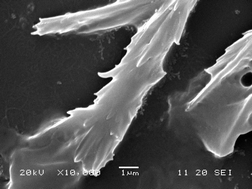2D Self-assembly of an amido-ended hyperbranched polyester induced by platinum ion coordination effect†
Abstract
Compared with amphiphilic

* Corresponding authors
a
Key Laboratory of Catalysis and Materials Science of the State Ethnic Affairs Commission & Ministry of Education, South-central University for Nationalities, Wuhan, Hubei Province, China
E-mail:
zhangdh27@163.com
Fax: +86-27-67842752
Tel: +86-27-67842752
b Key Laboratory for Green Chemical Process of Ministry of Education, Wuhan Institute of Technology, Wuhan, Hubei, China
c
Department of Electronics, Graduate School of Information Science and Electrical Engineering, Kyushu University, 744, Motoota, Nishiku, Fukuoka, Japan
E-mail:
liu@o.ed.kyushu-u-ac.jp
Fax: +81-92-8023629
Tel: +81-92-8023629
Compared with amphiphilic

 Please wait while we load your content...
Something went wrong. Try again?
Please wait while we load your content...
Something went wrong. Try again?
D. Zhang, J. Li, J. Wang, S. Chen, J. Zhou, T. Li, J. Zhang, A. Zhang and C. Liu, RSC Adv., 2013, 3, 17073 DOI: 10.1039/C3RA42057D
To request permission to reproduce material from this article, please go to the Copyright Clearance Center request page.
If you are an author contributing to an RSC publication, you do not need to request permission provided correct acknowledgement is given.
If you are the author of this article, you do not need to request permission to reproduce figures and diagrams provided correct acknowledgement is given. If you want to reproduce the whole article in a third-party publication (excluding your thesis/dissertation for which permission is not required) please go to the Copyright Clearance Center request page.
Read more about how to correctly acknowledge RSC content.
 Fetching data from CrossRef.
Fetching data from CrossRef.
This may take some time to load.
Loading related content
